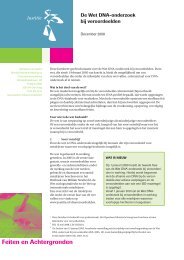INTERPOL HANDBOOK ON DNA DATA EXCHANGE AND PRACTICE
INTERPOL HANDBOOK ON DNA DATA EXCHANGE AND PRACTICE
INTERPOL HANDBOOK ON DNA DATA EXCHANGE AND PRACTICE
Create successful ePaper yourself
Turn your PDF publications into a flip-book with our unique Google optimized e-Paper software.
the process of dna analysisThe biological material that is to be tested (blood, semen, saliva, etc) needs to bedelivered in a suitable form to the laboratory. This may involve swabbing of large itemsand analyzing the swab, cutting a stain from an item of clothing, or using adhesive tapeto remove skin cells from an item that a person has touched.Extraction<strong>DNA</strong> is extracted from the cells by removing all of the proteins, membranes and othercellular material that can be present in a biological sample. There are different principlesthat are applicable: one of them is the affinity of <strong>DNA</strong> to membrane silica that allows forbinding and releasing <strong>DNA</strong>, therefore, making the removal of residual cell componentspossible. Another principle makes use of the water solubility that separates <strong>DNA</strong>from the lipophilic cellular elements. In an ideal world the pure extracted <strong>DNA</strong> is resuspendedin a buffer or bi-distilled water and ready for <strong>DNA</strong> typing.Quantitation<strong>DNA</strong> quantitation is an important step in the analysis. Here, the amount of extracted<strong>DNA</strong> obtained from the cells is determined. The concentration of extracted <strong>DNA</strong>varies strongly depending on the nature and size of the investigated tissue and usuallyranges between zero and some hundred nanograms (ng). The sensitivity of downstreamgenotyping applications is around 20 cells (approx. 130pg <strong>DNA</strong>) under standardlaboratory conditions.AmplificationThis stage increases or amplifies, the very small amount of <strong>DNA</strong> that is present inforensic samples to an amount that will allow a <strong>DNA</strong> profile to be detected. PCR doesthis by splitting each <strong>DNA</strong> molecule (double-stranded) into two pieces and using thetwo single strands as a template for new <strong>DNA</strong> molecules. The missing half of the <strong>DNA</strong>helix is rebuilt on to each of the two original pieces. This results in two complete <strong>DNA</strong>molecules, each identical to the first. The whole doubling process is performed overagain, twenty-five to thirty-five times in a row, ideally doubling the total number of <strong>DNA</strong>molecules present at each stage. This results in a final number of <strong>DNA</strong> molecules severalmillion times higher than the original starting number. In this way, PCR amplificationcan turn tiny amounts of <strong>DNA</strong> into an amount large enough to create a <strong>DNA</strong> profile.For human identification so-called Short Tandem Repeats (STR) became the markersof choice as they display a great variance of alleles in a given population. Therefore theycan be used to effectively discriminate between unrelated individuals. Today more than10 unlinked STR markers are co-amplified in a single multiplex PCR that results in aso-called STR-profile, statistically discriminating well beyond one individual in a billion.ElectrophoresisElectrophoresis is a method designed to separate <strong>DNA</strong> fragments differing in size.A multiplex PCR-amplified STR-profile contains multiple STR fragments that havedifferent fragment lengths depending on the individual alleles. Through electrophoresisPAGE 88 APPENDIX 3what is forensic dna profiling?







